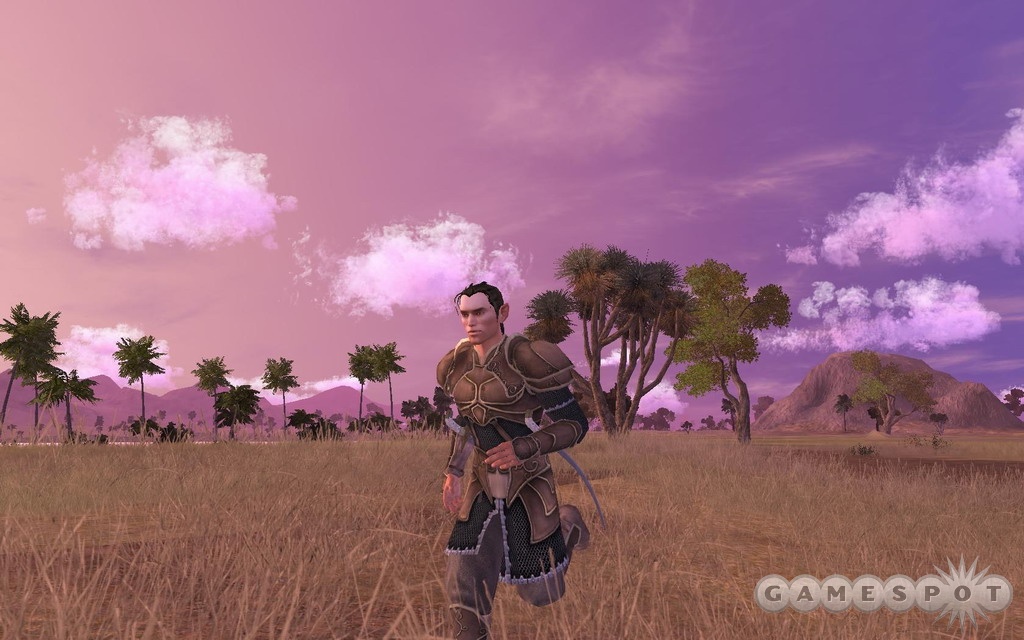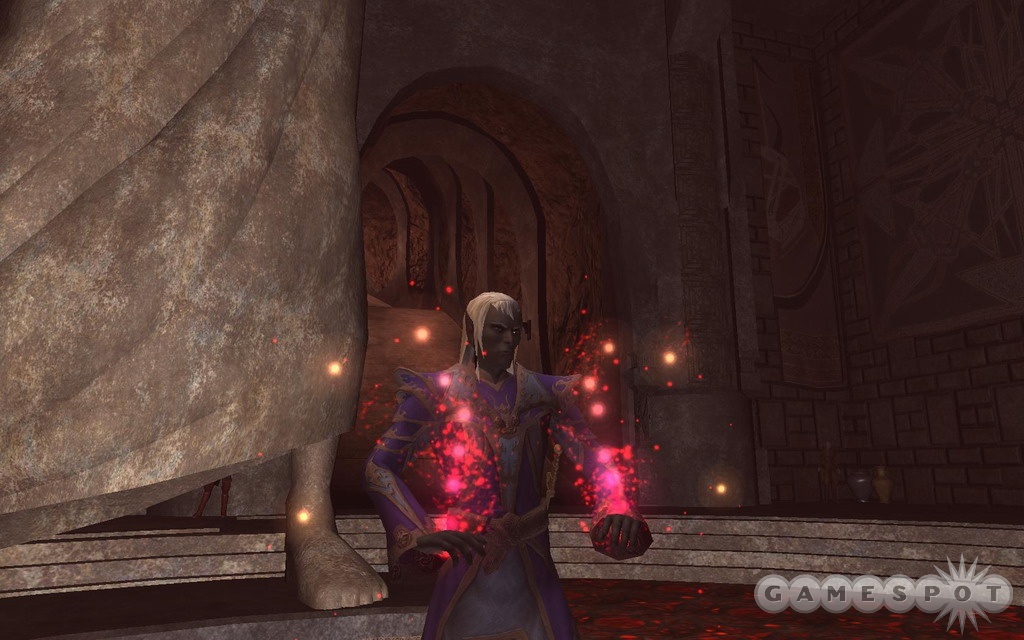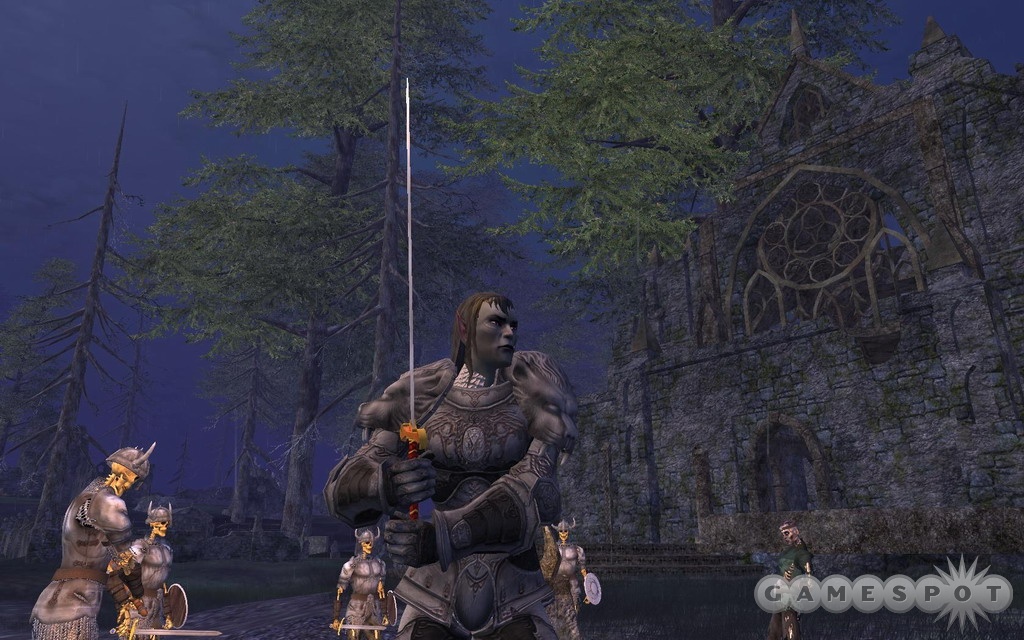Vanguard: Saga of Heroes Profile Preview - The Bard, Blood Mage, Cleric, Disciple, and Dread Knight Classes
Get an overview of five character classes in this upcoming massively multiplayer role-playing game by some of the creators of EverQuest.
The popular massively multiplayer role-playing genre that lets you adventure online with thousands of other players is set to get even bigger next year with the release of Vanguard: Saga of Heroes, the debut title from Sigil Games. There's a lot of potential in Vanguard, as it is being created by some of the creators of the groundbreaking game EverQuest. This is a fantasy-themed game set in a world populated by humans, elves, dragons, and other mystical creatures. You'll be able to create your own unique character which you'll use to explore this vast world. This character will be based on one of the many character classes in the game. We've got an overview of five of those classes below, and we'll have details on the others later on. For now, read on and find out more about the bard, blood mage, and others. Vanguard is looking to launch early next year.

Bard
The bard is a musical warrior, capable of singing powerful songs that can affect friends and enemies. Like a composer, bards are able to stitch together different song components, some of which will be unlocked over the course of the game. Below are the various component types.
Melody: Each song requires a single melody, which provides the structure for the overall song. A song can have only one melody, but you can add other components to reinforce it. An example of a meloldy is Mellarien's Athem of War, which inspires allies in battle and adds damage to all attacks and spells.
Embellishments: Songs can have up to five embellishment slots, and embellishments are minor additions to the melody that add resistance buffs, debuffs, and minor buffs. A sample embellishment is Illestine's Harmony of Warmth, which protects allies from cold damage.
Lyrics: There are up to four lyric slots in each song, and these can provide a wide range of low-level effects, such as slowing the enemy, being able to levitate, and boosting run speed. An example is Gamael's Blades of Flame, which adds additional fire damage to attacks.
Chorus: A chorus is a higher-powered lyric. As such, you can do more with a chorus, such as being able to project a shield around your party using Irion's Chorus of Shields. Songs have up to three chorus slots.
Verse: Verses are high-powered components that can provide a variety of effects, such as being able to snare enemies or regenerate the health of your party using Cirel's Phrase of Renewal. There are up to three verse slots in a song.
Bridge: Bridges are another type of powerful song component, providing miscellaneous effects. For instance, you can use Naman's Ruinous Revolution to strip enemies of arcane or elemental resistance. Each song has up to two bridge slots.
Coda: A coda comes near the end of a song, and here's where you start to see some very powerful effects, which is fitting for a finale. An example is Mellarien's Victorious Finale, which adds damage to all of your party's attacks. Songs can have up to two coda slots.
Rests: The final component type doesn't add power, but it's extremely important. The more powerful a component used in a song, the more energy it uses up. By inserting rests into a song, the bard can recharge the song's power and keep the song going for longer periods of time.

Blood Mage
As you might tell from this class's name, the blood mage specializes in blood magic, a powerful form of magic that can dish out extremely powerful damage spells as well as potent healing spells.
Heals and Buffs: Blood mages can heal individual characters, as well as whole groups, which makes the blood mage a natural party healer. An example of the blood mage's healing abilities is scarring pact, where the blood mage can help a teammate stay alive by magically linking with that character and absorbing some of the damage the teammate incurs. This means that the teammate only receives 70 percent of the original damage, while the blood mage incurs 150 percent of the remaining damage. Another example is blood gift, where you can use your blood to heal a teammate instantly. However, this comes at the price of your own health.
Blood Union and Rituals: Blood mages only have so much of their own blood that they can draw upon, but they can also form a blood union with an enemy to siphon the enemy's blood. Not only that, blood from a blood union can be combined with mana to create blood rituals. For instance, the ritual of shielding lets you shield your party from incoming attacks. Each attack drains hit points from the shield, and once the hit points are depleted, the shield drops. The ritual will use up all of your blood-union points, and the shield has 200 hit points for each level of blood union you've achieved. Or, the scarlet ritual lets you summon negative energy from a blood union and use it to inflict large amounts of damage. Doing this removes four blood-union points.
Life Transferring: The blood mage can transfer various energies using the blood union. An example of this ability is entwining vein, which lets the blood mage steal health from an enemy and transfer it to an ally. The ally heals for 50 percent of the damage done to the enemy, and this increases by 10 percent for every level of blood union that you have. Another example is physical transmutation, where the blood mage transforms his or her endurance to health. The downside is that you lose 50 percent of your current endurance, though you are healed 200 percent of the drained endurance.
Symbioses: The blood mage can create symbiotic creatures that attach themselves to the blood mage and his or her allies. To create a symbiont, though, you need a fresh organ and a vial of your own blood. The nature of the symbiont depends on the organ used. With the steal mortality ability, you can steal the dying breath of an opponent by ripping an organ out of its body. This only works when the opponent has less than 5 percent of its health remaining. Meanwhile, the attach conducive symbiont ability lets you attach a conducive symbiont on yourself and grants you the ability to use the conducive blood ability, which lets you heal allies more effectively.
Spell Casting Focuses: Blood mages can also have spell-casting focuses that focus on different areas of combat. For instance, the focus of Gelenia lets the blood mage trade health for power. As the blood mage loses health, he or she gains increased damage, immunity to poison and disease, and more.
Cleric

The cleric is a spiritual warrior and spellcaster, capable of drawing upon divine powers to cast powerful healing spells or equally powerful destructive spells. Clerics in Vanguard don't pledge themselves to a specific god, though. Instead, they can draw upon the power of all of the gods.
Affinities: Affinities let clerics focus on a specific aspect of a god. A cleric only has a limited number of affinities, and each affinity is tied to a specific god. Below is a list of sample affinities.
Affinity: Death
Deity: The Sisters
Ability: Increased damage to all megaspells
Affinity: Light/Purity
Deity: Fieros
Ability: Calls down a sunbeam, which wipes out undead opponents and blinds other opponents
Affinity: Life
Deity: Gloriann
Ability: Increased hit point buffs, increased potency for poison cures, and increased constitution buffs
Affinity: War
Deity: Ghaln
Ability: Power of Carnage, a major combat buff
Affinity: Travel
Deity: Finch
Ability: Immunity to roots and snares, while boosting potency of root spells. At higher levels, unlocks sojourn ability, which buffs levitation, water breathing, swimming speed, invisibility, and run speed

Disciple
Disciples are melee fighters that focus on inward serenity and strength. This gives them the ability to perform devastating melee attacks and counterattacks, as well as the ability to serve as a healer.
Attack Chains: Disciples can chain attacks together to perform amazing combat feats. An attach chain uses a set of attacks as openers and can reuse the set of attacks as bridges for different effects. For example, the blessed wind attack can deal a small amount of damage and heal your defensive target over time if used as an opener. If used as a bridge, the blessed wind deals a small amount of damage and instantly heals your defensive target.
Focus Bonds: Focus bonds are metaphysical bonds between the disciple and a target. If the target is hostile, a dissonant bond is formed. If the target is an ally, a harmonic bond is formed. The disciple can only form a few bonds at any one time, though they can be very useful. For instance, the touch of woe bond ties the disciple to an enemy. The enemy takes damage every time he or she tries to attack.
Counter Attacks: The disciple can deliver swift counterattacks thanks to special abilities like paralyzing touch, which paralyzes an opponent. This lets you set up a powerful attack while the enemy is frozen. The effect wears off over time, or until the enemy is hit.
Heals: Disciples can heal themselves and allies alike. An example of this is the breath of renewal ability, which heals a specific ally a small amount while also giving a small boost to nearby allies. Or, the discipline of harmony ability heals a specific ally for a small amount of health, but the ability becomes more effective after each successive use.

Dread Knight
The dread knight is a shadowy warrior who can inflict fear in any opponent. While not as honorable as paladins, the dread knight is a formidable and effective warrior.
Melee Proficiency: Dread knights are excellent melee warriors, armed with various skills and abilities, some of which might be considered underhanded. For example, the harrow ability can only be used if the dread knight is behind the target. But harrow lets the dread knight feed off the pain of an opponent, dealing damage and draining health at the same time. The ravaging darkness ability deals damage to an opponent over time and also drains the target's endurance. The longer an opponent remains affected by ravaging darkness, the more likely the target will be affected by the dread knight's dreadful countenance, which is described below. And the enthralling nexus ability lets the dread knight rescue an ally from attack by diverting all attackers to focus on the dread knight.
Dreadful Countenance: The dread knight exudes an aura of fear that debilitates nearby opponents. At the second level, dreadful countenance turns into wave of despair, and your opponents will become further debilitated and more likely to flee. A dread knight can also cast the shadow incarnate spell, which turns the knight into a fearsome shadow, maximizing the dreadful countenance affect.
Spell Proficiency: The dread knight isn't just a melee warrior, as the class also has the ability to cast powerful spells. These spells include shadow step, which lets the dread knight teleport behind an opponent--a useful ability for stabbing someone in the back. The symbol of wrath spell increases the dread knight's damage, which is cumulative with the dreadful countenance ability. And vile howl causes opponents to flee in terror.
Got a news tip or want to contact us directly? Email news@gamespot.com
Join the conversation